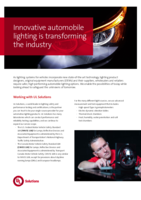
Automotive Lighting from UL Solutions
As lighting systems for vehicles incorporate new innovative technologies, original equipment manufacturers and suppliers (OEM and OES), wholesalers and retailers need safer, high-performing transportation lighting solutions.
High-quality automotive lighting plays an essential role in contributing to safer driving. Automotive lighting technology continues to evolve and advance, now incorporating high-powered LEDs and lasers that deliver outstanding light quality and critical beam control, allowing for improved visibility and safety in adverse weather conditions.
From adaptive front headlamps to signature exterior lighting and advanced infotainment and display panels, our vehicles’ safety and functionality continue to transform.
Innovative technologies in automotive lighting, such as LED and laser-based lighting systems, bring new challenges to testing and compliance with these regulations. LED lighting, for example, requires specific testing to ensure that it meets the FMVSS requirements for brightness, color, and beam pattern. Laser-based lighting systems also require testing to ensure that they do not cause glare or interfere with other drivers' vision. Furthermore, as automotive lighting systems become more complex and integrate with other vehicle technologies, such as sensors and cameras, there are additional challenges in testing and ensuring that these systems perform safely and effectively. This requires new testing protocols and standards to be developed to keep up with the latest innovations in automotive lighting technology.
FMVSS 108 (the Federal Motor Vehicle Safety Standard No. 108)
One significant change in recent years has been the incorporation of photometric testing for LED lighting. This testing ensures that LED lights comply with FMVSS 108's requirements for brightness, color, and beam pattern. Additionally, new requirements for adaptive headlights have been added to FMVSS 108, which test how well headlights adjust to different driving conditions such as curves, hills, and varying speeds.
SAE International, known as the Society of Automotive Engineers.
SAE has also established testing standards for electric and hybrid vehicles, including battery performance and safety requirements. As electric vehicle technology continues to evolve, we will continue to adapt to the needs of the industry.
UL Solutions, a world leader in lighting safety and performance testing and certifications, is the partner you can trust to be your single-source provider for your automotive lighting products. UL Solutions is recognized by the following agencies to test these main North American standards for automotive lighting:
For decades, UL Solutions has partnered with the entire supply chain for lighting distributors, electrical material manufacturers, retailers, architects and designers. In doing so, we have built a strong foundation under the automotive market with support for compressed design and development engineering, Production Part Approval Process (PPAP) timelines, and other automotive industry concerns involving complex timing.
We know the tight deadlines so often required in this highly competitive industry, and our testing facilities offer turnkey automotive lighting certification to FMVSS 108 and CMVSS 108.
Some specific UL Solutions lighting testing capabilities you’ll find at our laboratories include:
For the many different light sources, we use state-of-the-art measurement and test equipment that includes:
UL Solutions has many laboratories which can conduct performance and reliability testing capabilities, and we continue to expand our service scope.
We have the competency and capability to conduct testing to international requirements, including the standards of the Joint Electron Device Engineering Council (JEDEC), the standardization organization for solid-state and semiconductor industries, as well as the industry standard AECQ-102/SAE USCAR-33 for components in automotive electronics, IEC 60810/ISO 16750 for modules and NHTSA FMVSS108/SAE for vehicle lamps.
Equipment used to test to IES, EN, and UNI photometry standards and automotive lighting SAE, FMVSS and CMVSS requirements.
Watch as our engineers prepare the electro-dynamic chamber to test automotive lighting products for thermal shock and more.
Have questions, need specifics? Let's get this conversation started.